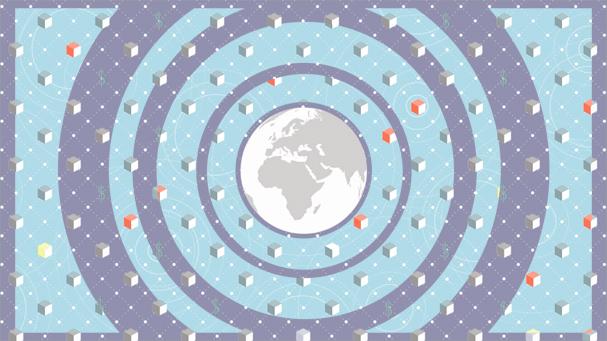Nine billion times nine billion is stuck in my head. Those are significant numbers all by themselves, but when you multiply them together they represent a very big story. Carl Bass, the CEO of Autodesk, tells me to think about it like a grid. Imagine nine billion people making things for nine billion people. I’ve been spending time with Carl and a number of other leaders of the Maker Movement. I thought I knew the story, but now I realize that we haven’t seen anything yet.
Carl’s vision for Autodesk is that their tools help nine billion people design just about anything from DNA molecules to Hollywood movies to skyscrapers. But the way he frames it is important. His vision isn’t that everyone makes things for themselves alone. The true power of the Maker Movement comes into play when people make things for each other. I found that out long ago. When I made something just for what I cared about the story was small. I was talking to myself. But when I began to tell stories for and with other people, universal themes emerged, people joined me on my journey, and we made things happen that no one person could do alone.
One of the most surprising things about my conversation with Carl is that Autodesk now has an entire consumer division dedicated to putting tools into the hands of everyone from eight to eighty. A few years ago if you wanted to use Autodesk software you needed to spend thousands of dollars on high-end workstations and work for a major company. Today you can visit a community site called Instructables and learn from other makers how to create just about anything. You can follow along with someone else’s, sometimes epic, story of failure and success and learn how make something yourself. Autodesk now has over 50 million monthly active users and they’ve built a community of makers that spans everything from kids learning how to build science fair projects to professionals making movies, shoes for Olympians, synthetic organisms to cure disease, and some of the world’s most advanced buildings.
But if making products for worldwide audiences were still controlled entirely by large organizations with massive factories the story would end there. While you could create big ideas, you would need to get permission to get them built at scale.
Factories join the social network
Mickey McManus—one of the authors of Trillions and a leader at MAYA Design that I’ve come to know over the last few years—thinks that factories are about to join the social network. “If you were trying to make a new car in the last century the person to talk to was Henry Ford,” he points out. Then he continues, “Almost a hundred years ago Ford started buying up land along the Rouge and Detroit rivers. His vision was to build the first vertically integrated factory and lock out smaller competitors through scale and process flow. At its height the River Rouge complex had over 120 miles of conveyor belts, 93 buildings and produced a car every 49 seconds. Raw materials came in one end and cars went out the other. Soybeans were converted into plastic parts. 700,000 acres of Ford’s forests were harvested for wood and paper pulp. Ford had iron mines, limestone quarries, glass furnaces and a power plant that could power a city. If you wanted to make cars that people could afford, you needed to control every step of production and turn workers into a part of one vast machine.” Ford’s vision represented the pinnacle of the first industrial revolution.
New technologies like 3D printing, computer controlled mills, laser cutters, robotics, and the Internet started lowering the barriers of production and a revolution called the Maker Movement began.
Mickey and a few other pioneers have been doing experiments in what it means to flip the idea of a factory on its head. They’ve been exploring the concepts around the Internet of Things and the next industrial revolution and I think they’re onto something.
Imagine practically anyone being able to become his or her own version of Henry Ford. What if you could click a button or touch a screen and take control of a factory that isn’t a single city-scale complex but is rather massively distributed around the world. Imagine that instead of having to ship materials from one end of the world to the other you could harvest them all from within a few miles away. Consider the power of your product and brand if your customers could take over the factory and tell their own stories.
It’s hard to get your head around this sort of idea unless you have a taste of what it means. And a taste is exactly what festivalgoers at the recent South by Southwest (SXSW) interactive festival got from an experiment that Mickey’s team ran called the Trending Vending lounge. (LINK:http://www.linkedin.com/today/post/article/20140313143853-4168330-sxsw-when-factories-join-the-social-network )
They worked with Oreo and Twitter to bring two micro-factories to Austin. They were effectively 3D food printers hooked up to the Internet. Every two minutes a custom Oreo cookie rolled off the assembly line based on trending stories from Twitter. In essence you could “Eat the Tweet” or design your own cookie—mixing flavors and design patterns of icing in real time. People stood in line for hours to get a taste of the future. At one point the #SXSW started trending and the machines printed cookies about the festival itself. (LINK:http://vimeo.com/88702704 )
Mickey notes, “Imagine a few years from now when Trending Vending machines go mainstream and flip the idea of vertically integrated factories inside out. What if the machines were connected to your Nike Fuel band? If you worked out extra hard today, maybe the cookie it makes just for you is a little bit sweeter. Customers could design their own cookies and may even come up with best selling flavor combinations that do better than Oreo’s own food scientists. What if Oreo didn’t only make cookies but also minted Oreo tycoons who shared in the success of a best selling new flavor?”
Out of nine billion people, a few of them probably do have better ideas than the employees of any one particular company. Nine billion by nine billion translates into dollars and cents. Part of the movement in the Maker Movement is entrepreneurial. It’s about lowering the barrier so far more people become a part of the innovation economy.
That’s where Mark Hatch jumps into the conversation. Mark Hatch is the CEO of a new kind of community for makers called TechShop that—as near as I can tell—is like a health club for the mind combined with a social network combined with the most distributed factory floor on the planet. Instead of working out your body, you work out your maker skills. Along the way you build a network of connections to reduce the time to invent new ideas—and produce them—from months and years to weeks and days. Mark tells me about the members and projects at his shops. The world’s fastest electric motorcycle was built at TechShop, not at a major vehicle manufacturer. A little accessory for your smart phone that turns it into a cash register, called Square, wasn’t built by a major global bank, it was built at TechShop by a glass artist and a social network entrepreneur. A new kind of neonatal blanket to keep premature babies warm in emerging countries? TechShop. Hundreds of companies, thousands of jobs, and $100s of millions of dollars of revenues have all come out of TechShop’s community and it’s just getting started.
Nine billion times nine billion also means that there are some people who will never stop serving others, who’s hearts are deeply connected to the Maker Movement.
They have over 6,000 members and most heartening of all? Over 1,000 of those members are veterans learning how to become entrepreneurs, making real things for themselves, their families, and others. Nine billion times nine billion also means that there are some people who will never stop serving others, who’s hearts are deeply connected to the Maker Movement. In fact Mark himself is a vet. The more I get to know him the more I think he’s a revolutionary fighting the biggest battle in his life. His mission is a wake up call about the power of makers.
The night I met Carl Bass I reconnected with Bre Pettis. He’s a former schoolteacher who is the founder of a company called Makerbot. When we talk about 3D printers and the tools of the next industrial revolution, Bre will probably go down as one of this generation’s Edisons. Just as Thomas Edison helped make light bulbs seem commonplace, Bre has taken 3D printing and put it into the hands of schoolteachers, children, dreamers, and entrepreneurs. He’s lowered the barrier to entry for the Maker Movement so that just about anyone can play.
Most recently he teamed up with school teachers across the country, Donorschoose.org, and the White House’s manufacturing accelerator, called America Makes, to bootstrap what can only be described as a “one 3D printer per child” initiative. Out of nine billion people many of them are children that will lead the movement tomorrow. Helping them learn how to dream bigger is an integral part of the story that is shaping the movement. In fact the White House recently announced that they’d be hosting their first Maker Faire this year to signal the importance of the movement from the standpoint of rebooting manufacturing and innovation across the country. (LINK:http://www.whitehouse.gov/blog/2014/02/03/announcing-first-white-house-maker-faire )
Tutorials are the advertisements of the next industrial revolution.
As I learn more about the story that shows up in the headlines and the behind the scenes stories that these innovators share with me, I realize that the traditional models of business and consumption are falling by the wayside. We don’t want to hear a tale about how product X or brand Y will make us feel through artificial narratives. We want to learn how to tell our own stories, how to build our own ideas and make them a reality. The media is made of the product itself and the story that we tell with what we make. We don’t need permission any longer to make something our own. We have a factory in our home or down the street. Soon the days of making a million of the same product and hoping that you can get people to like what you made through clever marketing will be gone. The next generation, those nine billion people who are just starting out on their own journey, they want to make what they like. They want to make things just for themselves or make things for the people they care about. Tutorials are a special kind of story—part recipe, part travelogue—about how we can all be a part of the nine billion by nine billion person strong revolution.


